|
|
|
Sort Order |
|
|
|
Items / Page
|
|
|
|
|
|
|
| Srl | Item |
| 1 |
ID:
120626
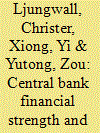

|
|
|
|
|
| Publication |
2013.
|
| Summary/Abstract |
Using a unique monthly data set over the period 2000:1-2008:12, this paper presents empirical findings on China's central bank, the People's Bank of China, from the viewpoint of its financial strength and the cost of monetary policy instruments. The results show that PBoC is constrained by the costs of its monetary policy instruments. PBoC tend to use less costly but market-distorting instruments such as the deposit interest rate cap and reserve-ratio requirements, rather than more market-oriented but more costly instruments such as central bank note issuance. These costs remain under control today, but may rise in the future as PBoC accumulates more foreign assets. This, in turn, will jeopardize the Chinese monetary authority's capability to maintain price stability.
|
|
|
|
|
|
|
|
|
|
|
|
|
|
|
|
| 2 |
ID:
130535


|
|
|
|
|
| Publication |
2014.
|
| Summary/Abstract |
The increasing share of imported food in developed countries, such as the U.S. and European Union countries, poses new challenges for food safety and quality regulators. China as the world's biggest food producer has the fastest growing share of fish and shellfish exports to these countries. While there have been an increasing number of studies conducted on consumer demand for various food product attributes, little research has been focused on producer behavior, and studies on Chinese food producers are especially absent in the literature. The objective of this study is to assess Chinese aquaculture producers' willingness-to-change (WTC) and adopt certain production practices related to food safety. Producer preferences for enhanced food safety measures, and sustainable/eco-friendly production practices are assessed using a choice experiment. Primary data was collected in the leading aquaculture producing provinces of southern China. The average net income per farmer of our sample was 81,286 RMB/year of which approximately 72% originated from their aquaculture operation. Derived WTC estimates from a random parameters logit model suggest that the representative Chinese producer would require a 2.49% premium per jin of fish to adopt enhanced food safety practices such as those required for China GAP, and No Public Harm voluntary certifications and they would accept a 3.22% discount before being indifferent between having an antibiotic-free facility and using antibiotics. WTC estimates of sustainable eco-friendly practices and verification by various entities were also assessed. A latent class model (LCM) is used to segregate producers into group with similar underlying characteristics to develop policies to improve producer practices and ultimately product safety and quality.
|
|
|
|
|
|
|
|
|
|
|
|
|
|
|
|
| 3 |
ID:
130539


|
|
|
|
|
| Publication |
2014.
|
| Summary/Abstract |
This paper measures the economic impacts of climate change on China's grain production by using provincial time series data over a 32-year period. The panel data model and time series region model with/without adaptation are applied at the same time to assess the effectiveness of a common production function. To capture the effects of weather variables we employ a random coefficients model where the production elasticities are the logarithmic function on temperature and rainfall. A Cobb-Douglas production function with additional interaction between inputs and climate variables is applied. We find that the economic impacts of climate change are mixed, that is, some regions are winners and others are losers, and the effect is crop-specific, not general. With adaptation, the economic impacts of warming on grain production are always positive; less precipitation will benefit rice production, but will harm wheat and maize production. Most of the central, western and northern China, which have already been adapted, are less sensitive to climate variables, but some eastern provinces, such as Shandong and Hebei, are very vulnerable. However, this study finds that the adaptation by irrigation is not sensitive to climate change. In summary, the analysis indicates that policymakers should recognize that the climate change would change the productivity of factors, so a regional and crop-specific total-factor-adaptation model is recommended.
|
|
|
|
|
|
|
|
|
|
|
|
|
|
|
|
| 4 |
ID:
120623
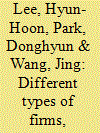

|
|
|
|
|
| Publication |
2013.
|
| Summary/Abstract |
Using highly disaggregated HS 8-digit product-category level data collected by the Chinese Customs Office for 2000 and 2008, we perform an in-depth anatomy of China's imports of manufactured goods. We estimate both the extensive margins - number of products imported per product group or trade partner - and intensive margins - amount of imports per product group or trade partner - of China's imports. Our paper contributes to the literature of firm heterogeneity in international trade in three different ways. First, we distinguish firms into foreign firms and domestic firms, which are further divided into private firms and public firms. Second, we distinguish products into final goods and intermediate goods. Third, we estimate gravity equations from the perspective of dynamics utilizing a dynamic adjustment model. Overall, our analysis yields a number of new stylized facts about China's imports. These, in turn, help us to gain a fuller understanding of China's trade patterns in light of its recent emergence as a globally significant importer.
|
|
|
|
|
|
|
|
|
|
|
|
|
|
|
|
| 5 |
ID:
120621
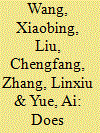

|
|
|
|
|
| Publication |
2013.
|
| Summary/Abstract |
The rapid expansion of enrollment capacity in China's colleges since the late 1990s has come at the price of high tuition hikes. China's government has put forth financial aid programs to enable poor students to access higher education. Although studies have shown that poor high school students are indeed able to attend college when their test scores are high enough (that is, few are unable to attend when they are qualified to attend), the literature has not explored whether poor students have sufficient amounts of aid to thrive in college.
Using findings from a randomized controlled trial, this study evaluates the impact of providing full scholarships to students from poor rural areas (henceforth treatment students) on student stress levels, self-esteem/self-efficacy, and participation in activities in four first-tier colleges. To do so, we compare outcomes of the treatment students with students who were not given full scholarships by the project (and were left to search for scholarships and other sources of financial aid from the university system itself-the control students). The project was run among the 200 poorest first-year students in four first-tier colleges in inland China. Somewhat surprisingly, we find that treatment students (those receiving full scholarships from the project) were only slightly more successful in obtaining financial aid than control students. This suggests that control students (those who did not receive full scholarships from the project) were still able to access comparable levels of financial aid. Most importantly, scholarship recipients were statistically identical in outcome to control students in terms of stress, self-esteem, and participation in college activities, suggesting that poor students (who are dependent on aid from the university system) currently are able to access sufficient levels of financial aid, are able to take advantage of the activities offered at college, and do not shoulder heavy financial or psychological costs.
We find, therefore, that efforts of the government to alleviate the financial burden of college on the poor have been relatively successful in first-tier colleges. Because of this, foundations and individuals may decide that if they want to improve human welfare, giving additional scholarships at high tier colleges may be having little effect.
|
|
|
|
|
|
|
|
|
|
|
|
|
|
|
|
| 6 |
ID:
120620
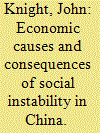

|
|
|
|
|
| Publication |
2013.
|
| Summary/Abstract |
This paper provides a survey of the economic literature relevant to social instability in China and moulds it into an argument. The objective is to offer a fresh view of economic policy and performance through the lens of the threat posed by social instability. This is a concept that economists rarely analyse, and yet it can lurk behind much economic policy-making. China's leadership has often publicly expressed its concern to avoid 'social instability'. It is viewed as a threat both to the political order and to the continued rapid growth of the economy. This threat to growth in turn endangers the maintenance of social stability. The paper examines the likely economic determinants of social instability, using both surveys and other evidence. After discussing the determinants of China's rapid growth, the paper goes on to examine the likely mechanisms by which social instability can affect the growth rate. There is a case for more research on the role of social instability in the economic development process.
|
|
|
|
|
|
|
|
|
|
|
|
|
|
|
|
| 7 |
ID:
120625


|
|
|
|
|
| Publication |
2013.
|
| Summary/Abstract |
We investigate the transmission mechanism of monetary policy in China over the past decades with emphasis on the post-Asian crisis period. A factor-augmented VAR method is used to study the effectiveness of monetary policy instruments in stabilizing the Chinese economy. We find that repo rate, benchmark lending rate, and a market-based monetary stance have little impact on the Chinese economy, and are only mildly effective when the exchange rate is more market-determined. The non-market-based measures of People's Bank of China, such as growth rates of total loan and money supply, are effective in adjusting the real economy and price level. Given the slow pace of exchange rate reform, China is likely to continue employing non-market-based policies in the near future.
|
|
|
|
|
|
|
|
|
|
|
|
|
|
|
|
| 8 |
ID:
130541
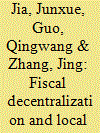

|
|
|
|
|
| Publication |
2014.
|
| Summary/Abstract |
Since the tax-sharing reform in 1994, the Chinese fiscal system has exhibited a marked vertical fiscal imbalance-a mismatch between expenditure and revenue assignments-at the local levels, which may cause the common-pool problem in local governments' behavior. Using a large fiscal dataset at the county level from 1997 to 2006, this paper studies the effects of fiscal decentralization on local expenditure policy and analyzes how the vertical fiscal imbalance shapes these effects. The estimation results show that expenditure decentralization increases government spending and leads to a fund allocation with a larger weight on capital construction and smaller weights on education and administration. In contrast, revenue decentralization has little influence on local government expenditures. We show that the differences in the effects of expenditure and revenue decentralization can be attributed to the distortionary effects caused by the vertical fiscal imbalance and, thus, offer support to the importance of the common-pool problem at the county level of China's fiscal system.
|
|
|
|
|
|
|
|
|
|
|
|
|
|
|
|
| 9 |
ID:
130538
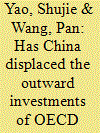

|
|
|
|
|
| Publication |
2014.
|
| Summary/Abstract |
As China has rapidly emerged as one of the world's largest investors abroad, there has been a hectic debate in the literature on whether its emergence as a major foreign investor may have undermined the importance of western industrialised economies, including those in the Organisation for Economic Cooperation and Development (OECD). This paper aims to investigate whether this is the case. The study uses a panel dataset covering 155 countries, including 33 in the OECD, where China had invested during 2003-09. This is by far the most comprehensive dataset of China's outward foreign direct investment (OFDI). A two-stage least squared (TSLS) regression approach is adopted for our econometric models according to an established augmented gravity model in the literature. The empirical results show clear evidence that China's OFDI displaces that of the OECD countries, but the argument that China's emergence is a 'new colonialism' is not supported as OECD countries' OFDI in resource abundant host countries, particularly that in Africa and Latin America, does not appear to have been displaced by China's OFDI.
|
|
|
|
|
|
|
|
|
|
|
|
|
|
|
|
| 10 |
ID:
120624


|
|
|
|
|
| Publication |
2013.
|
| Summary/Abstract |
This paper studies how the evolution of market forces affects executive compensation in China's listed state-owned enterprises (SOEs) from 2000-2007. Along with the progress of market reforms we find that the level of executive compensation increases gradually and the relation between compensation and performance becomes more sensitive. However, the effect of market forces on executive compensation in SOEs is limited by CEOs' political connections. Our findings suggest that introducing exogenous market forces alone may not be sufficient to ensure the effectiveness of governance structure in a transition economy.
|
|
|
|
|
|
|
|
|
|
|
|
|
|
|
|
| 11 |
ID:
130542


|
|
|
|
|
| Publication |
2014.
|
| Summary/Abstract |
This paper calculates CO2 emissions embodied in China's international trade using an input-output analysis, for the period 2000-2010. Based on industrial panel data, the two-step GMM estimation is used to test the impacts of FDI, trade openness, exports, imports and per capita income on CO2 emissions. The results suggest that: (1) China's growing trade surplus is one of the important reasons for the rapidly rising CO2 emissions; (2) large FDI inflows further aggravate China's CO2 emissions; and (3) the industrial sector's per capita income and CO2 emission relationship show inverted-U environmental Kuznets curve. Therefore, in order to achieve environmentally sustainable development of the economy, China should make efforts to transform its trade growth mode, adjust foreign investment structure, strengthen energy efficiency and develop a low-carbon economy.
|
|
|
|
|
|
|
|
|
|
|
|
|
|
|
|
| 12 |
ID:
120619


|
|
|
|
|
| Publication |
2013.
|
| Summary/Abstract |
We estimate a theory-based modified gravity model to analyze the effects of foreign direct investment (FDI) to China on FDI to other countries over the period 1990-2004. Our results suggest that on average, ceteris paribus, FDI flows to China have been complementary to FDI flows to other countries. However, these complementarities exhibit a decreasing trend over time and vary between and within country groups. Furthermore, our results suggest that while the FDI to China has encouraged both horizontal and vertical FDI to other countries, these FDI complementarities have been strongest in the case of vertical FDI.
|
|
|
|
|
|
|
|
|
|
|
|
|
|
|
|
| 13 |
ID:
130534
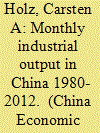

|
|
|
|
|
| Publication |
2014.
|
| Summary/Abstract |
Monthly economic indicators are used for a variety of purposes, from studying business cycles to determining economic policy and making informed business decisions. China's published monthly industrial output statistics could hardly be more confusing, with changes in variables, in coverage, in measurement, and in presentation. This paper reviews the available official data and proceeds to construct a monthly industrial output series in nominal terms and in real terms for the period 1980-2012, economy-wide and for the public sector.
|
|
|
|
|
|
|
|
|
|
|
|
|
|
|
|
| 14 |
ID:
130536


|
|
|
|
|
| Publication |
2014.
|
| Summary/Abstract |
The most populous country in the world, China faces immense socio-economic challenges providing adequate pensions to its growing elderly population. In that country, pensions available to older people vary considerably across the country's various pension schemes. This paper calculates the fairness coefficients of these pensions based on pension income, contributions, demand, and generational gap. The analysis shows that the pension fairness coefficients are 0.53, 0.38, 0.95, and 0.82, respectively. Synthesizing pension income, contributions, demand, and generational gap, the paper suggests that, in China, old-age pensions across different schemes are absolutely unfair. Finally, it analyzes the superficial and deeper factors behind pension unfairness in China before providing policy recommendations for improving the fairness of the country's pension system.
|
|
|
|
|
|
|
|
|
|
|
|
|
|
|
|
| 15 |
ID:
130537


|
|
|
|
|
| Publication |
2014, 2014.
|
| Summary/Abstract |
It is common to see patentees coexist with infringers in developing countries, which leads to a split of patent value between patentees and infringers. This paper extends traditional model for estimation of patent value. We classify patentees by technology level: Patentees with low technology level are motivated to imitate patentees with high technology level. This leads to an early lapse of patent right by patentees with both high and low technology level. With this model, we estimate the value of invention patents in China. Although patent value of Chinese firms is lower than that of foreign firms, the differences are not as large. This is mainly because of the existence of potential patent value. This value is dropped, since the motivation of imitating foreign patents leads to the lapse of their own patents. Technology contained in the patent would thus not be further developed. The infringement behavior is more likely to occur in technology fields with less technology gap between Chinese and foreign firms, which may be due to an easier copy of technology. The strengthening of patent protection works, as two patent law amendments in 1993 and 2001 reduces the infringement. Policy implications are made at the end of the study.
|
|
|
|
|
|
|
|
|
|
|
|
|
|
|
|
| 16 |
ID:
120622


|
|
|
|
|
| Publication |
2013.
|
| Summary/Abstract |
This paper estimates the impact of inter-sectoral linkages on productivity at the sectoral level. An exhaustive Chinese panel data set for capital, infrastructure and a sectoral agglomeration index is linked with an economic distance matrix derived from inter-sectoral transactions. The latter matrix can replace the conventional geographic distance matrix from spatial econometrics. The impact through spillovers is mixed-the direct impact passing to related sectors and back to the initial sector itself, and the indirect impact arising from changes in all sectors. The results suggest that (1) economic growth in a sector is driven by spillovers among sectors that are linked through flows of goods and services; economic distance plays a more important role in stimulating productivity spillover than spatial distance; a shorter economic distance transmits a larger productivity spillover between sectors; (2) infrastructure spillover improves labor productivity in linked sectors; (3) agglomeration diseconomies can be partially reduced by infrastructure investment.
|
|
|
|
|
|
|
|
|
|
|
|
|
|
|
|
| 17 |
ID:
130540
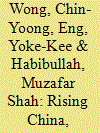

|
|
|
|
|
| Publication |
2014.
|
| Summary/Abstract |
Should Asia feel anxious about China's expansion? We look for the answer through the Bayesian estimation of a two-country New Keynesian model of production fragmentation covering ten Asian economies, including China. The estimates show that vis-à-vis China, the developed Asia has a more fragmented production structure with higher domestic value-added embodied in intermediates traded with China whereas the developing Asian production chains are equally if not less fragmented with more foreign value-added. We also find that China's expansion made possible by favorable demand and price shocks benefits all Asian neighbors. Expansion driven by total factor productivity improvement, however, lifts the aggregate value-added in the developing Asia but not in the developed Asia, unless the shocks symmetrically originate in both China and the developed Asia. Fixing the regional currencies irrevocably to the U.S. dollar amplifies the effect of China's productivity improvements, although it is nearly irrelevant for responses to other types of shocks. We conclude that production fragmentation and symmetry in shock are the keys to the answers of this question.
|
|
|
|
|
|
|
|
|
|
|
|
|
|
|
|
| 18 |
ID:
120627


|
|
|
|
|
| Publication |
2013.
|
| Summary/Abstract |
This paper examines empirical evidence of the adaptive learning behavior of speculators in the 2005-2008 renminbi appreciation episode, and establishes a theoretical model to explore appreciation policy implications of such a behavior. In our model, speculators form their expectations about the future appreciation premium adaptively by extrapolating past appreciation returns into the future. We find that a rapid appreciation may attract more capital inflows, and the central bank may prefer a slow appreciation to discourage capital inflows. Simulated results can generate hump-shaped paths of the appreciation speed, expected appreciation premium, and capital inflows. In addition, changes in the appreciation speed precede changes in the expected appreciation premium and capital inflows. These results are consistent with empirical evidence in the 2005-2008 renminbi appreciation episode.
|
|
|
|
|
|
|
|
|
|
|
|
|
|
|
|
| 19 |
ID:
130543


|
|
|
|
|
| Publication |
2014.
|
| Summary/Abstract |
This paper examines whether a casino tax is good for local welfare in a tourism economy. We find that what is important for efficiency is not the tax rate itself but the tax incidence on tourists. Casino tourism in Macao engages in price discrimination via market segmentation. We prove that, compared with the mass market, the VIP market will grow faster with a greater price rise if a tax hike on the VIP market is not large, but will grow less rapidly with a smaller price increase if the tax hike is very large. An empirical study is carried out using data from Macao, which is typical of segmenting markets for discriminatory pricing. We show that our theory is largely consistent with observed evidence. This paper also provides some policy recommendations useful for Macao. We propose that its casino tax should be kept low at its current rate in the mass market but be raised substantially in the VIP market if its economic growth is to be made less unbalanced and more sustainable.
|
|
|
|
|
|
|
|
|
|
|
|
|
|
|
|
|
|
|
|
|